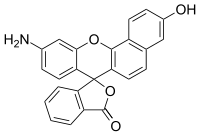Seminaphtharhodafluor
Seminaphtharhodafluor or SNARF is a fluorescent dye that changes color with pH. It can be used to construct optical biosensors that use enzymes that change pH.
 | |
| Names | |
|---|---|
| Other names
Seminaphtharhodafluorescein; Seminaphthorhodafluor | |
| Identifiers | |
3D model (JSmol) |
|
| ChemSpider | |
CompTox Dashboard (EPA) |
|
| |
| |
| Properties | |
| C24H15NO4 | |
| Molar mass | 381.387 g·mol−1 |
Except where otherwise noted, data are given for materials in their standard state (at 25 °C [77 °F], 100 kPa). | |
| Infobox references | |
The absorption peak of the derivative carboxy-SNARF at pH 6.0 is at wavelength (515 and) 550 nm, while that at pH 9.0 is at 575 nm.
The emission peak of carboxy-SNARF at pH 6.0 is at wavelength 585 nm, while that at pH 9.0 is at 640 nm.[1]
SNARF-1 can serve as a substrate for the MRP1 (multidrug resistance-associated protein-1) drug transporter, to measure the activity of the MRP1 transporter. For this purpose, an acetomethoxyester group is added to SNARF-1. Cellular esterases cleave off SNARF-1, and its transport out of the cells can be measured by following the loss of fluorescence from the cells.[2]
References
- http://www.lifetechnologies.com/order/catalog/product/C1270
- Weekes-MP et al., Science Vol 340, April 2013